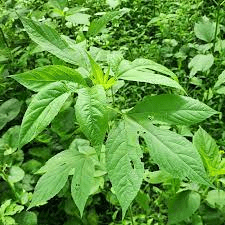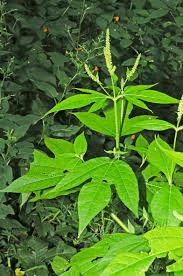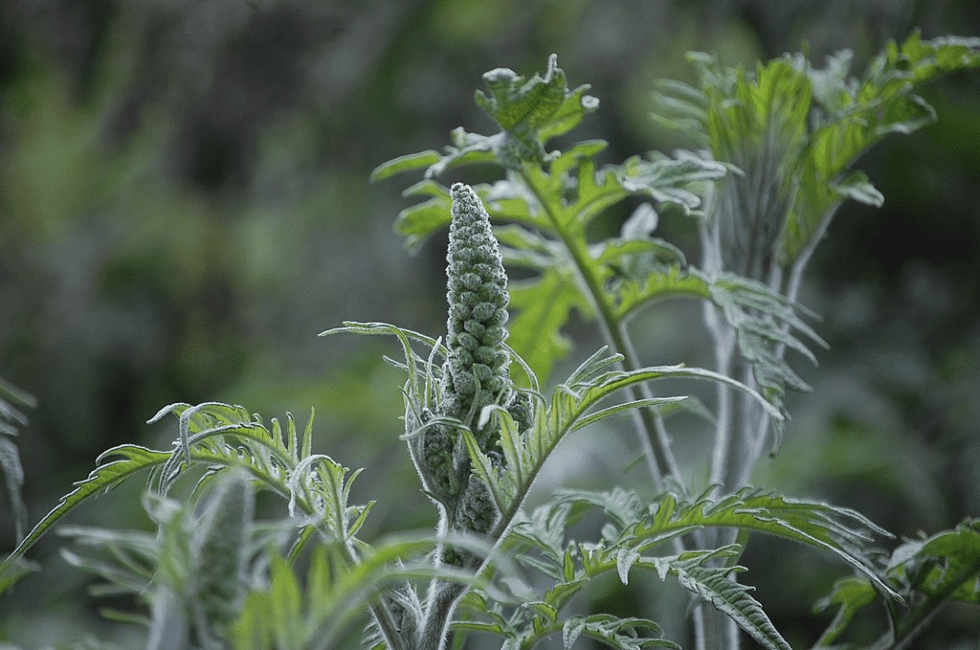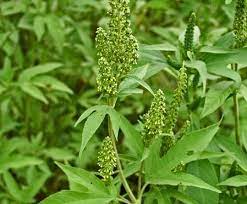Ambrosia arborescens, commonly known as Giant Ragweed, is a robust and imposing plant belonging to the Asteraceae family. Native to North America, this species is notorious for its rapid growth and significant ecological impact. Despite its negative connotations as a weed, Giant Ragweed plays a crucial role in the ecosystem and has some redeeming qualities.
Typically reaching towering heights of 10 feet or more, Giant Ragweed stands out with its coarse, serrated leaves and erect stems. The plant’s greenish flowers bloom in late summer and fall, arranged in dense clusters at the top of the stems. While the overall appearance may not be visually appealing to many, the plant’s resilience and adaptability are noteworthy.
Giant Ragweed has earned a reputation as an aggressive colonizer, often found in disturbed areas, along roadsides, and in agricultural fields. Although considered a weed, this plant serves as a valuable resource for various pollinators, including bees and butterflies, which are attracted to its abundant pollen.
However, Giant Ragweed’s ecological contributions are overshadowed by its propensity to produce copious amounts of allergenic pollen. The wind-dispersed pollen is a major contributor to hay fever and allergic reactions in susceptible individuals, making the plant a nuisance for allergy sufferers.
Despite its mixed reputation, some conservationists recognize the importance of Giant Ragweed in providing habitat and food for wildlife. Its deep roots contribute to soil stabilization, preventing erosion in certain ecosystems.
The Botanical Description of Ambrosia arborescens
Ambrosia arborescens, or Giant Ragweed, presents a complex picture in the botanical landscape. While its rapid growth and allergenic pollen may pose challenges, its ecological role and contribution to biodiversity should not be overlooked. Understanding the balance between its benefits and drawbacks is essential for managing and coexisting with this imposing plant.
1. Plant Structure: Ambrosia arborescens, commonly known as the giant ragweed, is a robust perennial plant that belongs to the Asteraceae family. It typically reaches heights of 8 to 16 feet, presenting a towering presence in its habitat.
2. Leaves: The leaves of Ambrosia arborescens are deeply lobed, resembling the shape of a palmate hand. The leaf edges are serrated, adding to the distinct appearance of the foliage.
3. Stem: The stem of the giant ragweed is sturdy and erect, featuring a greenish hue. The plant’s height is mainly attributed to the elongated, well-branched stem.
4. Flowers: Inconspicuous greenish-yellow flowers form in dense, elongated spikes at the top of the plant. The flowering season typically occurs in late summer to early fall.
5. Inflorescence: The inflorescence of Ambrosia arborescens consists of multiple tiny florets arranged in compact clusters, creating a characteristic spikelike structure.
6. Root System: The giant ragweed develops an extensive and deep root system, contributing to its resilience and ability to thrive in various soil conditions.
7. Habitat: Native to North America, Ambrosia arborescens is commonly found in open areas, along roadsides, in fields, and near water sources. It has a broad ecological range.
8. Pollination: The plant relies on wind pollination for reproduction, and its abundant pollen can be a source of allergies for some individuals.
9. Fruiting: Following successful pollination, Ambrosia arborescens produces small, dry fruits, each containing a single seed. These fruits are dispersed by the wind.
10. Seasonal Changes: The giant ragweed undergoes distinct seasonal changes, with the leaves turning from green to yellow in the fall, contributing to the plant’s visual dynamics.
The Geographic Distribution of Ambrosia arborescens

1. Native Range: Ambrosia arborescens is native to North America, with its natural range extending from Canada to Mexico. It thrives in a variety of climates within this expansive region.
2. North American Presence: The giant ragweed is prevalent in the central and eastern parts of the United States and southern Canada. It is a common sight in states such as Iowa, Illinois, Ohio, and beyond.
3. Soil Preferences: Ambrosia arborescens exhibits adaptability to different soil types, including well-drained soils, clayey soils, and loamy soils. This adaptability contributes to its wide distribution.
4. Human-Altered Habitats: The plant has also adapted to human-altered environments, frequently appearing in disturbed areas, agricultural fields, and along transportation routes.
5. Altitude Range: Ambrosia arborescens can be found at varying altitudes, from lowland areas to upland regions, showcasing its versatility in terms of elevation.
6. Invasive Characteristics: The plant’s resilience and prolific nature have led to concerns about its invasive potential in certain regions, impacting local ecosystems and biodiversity.
7. Urban Presence: Ambrosia arborescens is not limited to rural landscapes; it can also be found in urban and suburban areas, further highlighting its adaptability.
8. Climate Preferences: The giant ragweed prefers warm climates and is well-suited to regions with hot summers and adequate rainfall. However, it can endure a range of climatic conditions.
9. Biotic Interactions: Understanding the plant’s interactions with other organisms, including competition with native species, is essential for assessing its ecological impact.
10. Conservation Status: While not listed as endangered, Ambrosia arborescens’ invasive tendencies and potential impact on local ecosystems warrant monitoring and management efforts.
11. Global Spread: Beyond its native range, Ambrosia arborescens has been introduced to other parts of the world, emphasizing the need for international awareness and management strategies.
12. Ecological Niche: The giant ragweed occupies various ecological niches, playing a role in both natural and human-influenced landscapes, shaping its widespread distribution.
The Chemical Composition of Ambrosia arborescens
1. Allergenic Pollen: Ambrosia arborescens is notorious for producing allergenic pollen, which can trigger allergic reactions in sensitive individuals, causing hay fever symptoms.
2. Sesquiterpene Lactones: The plant contains sesquiterpene lactones, chemical compounds known for their bitter taste and potential medicinal properties, including anti-inflammatory effects.
3. Polyphenolic Compounds: Ambrosia arborescens may contain polyphenolic compounds, contributing to its antioxidant properties and potential health benefits.
4. Essential Oils: Some varieties of ragweed, including Ambrosia arborescens, may produce essential oils with distinct aromatic compounds.
5. Nitrogen Content: The plant is known for its ability to accumulate nitrogen, influencing soil nutrient dynamics and potentially impacting surrounding vegetation.
6. Medicinal Alkaloids: Certain alkaloids found in Ambrosia arborescens may have pharmacological significance, although research on their specific properties is ongoing.
7. Flavonoids: Flavonoids, known for their antioxidant effects, may be present in Ambrosia arborescens, contributing to the overall chemical profile.
8. Triterpenoids: Some ragweed species, including Ambrosia arborescens, may contain triterpenoids, which have diverse biological activities and potential medicinal applications.
9. Phytochemical Variability: The chemical composition of Ambrosia arborescens can vary based on factors such as environmental conditions, geographical location, and genetic diversity.
10. Pollen Proteins: The proteins present in ragweed pollen can elicit immune responses in susceptible individuals, leading to allergic reactions.
11. Impact on Soil Microorganisms: The plant’s chemical composition, particularly its nitrogen content, may influence soil microbial communities, affecting nutrient cycling.
12. Allelopathic Effects: Ambrosia arborescens may produce allelopathic compounds that influence the growth and germination of neighboring plants, showcasing its ecological interactions.
13. Phenolic Acids: Phenolic acids, known for their antioxidant properties, may be part of the chemical makeup of Ambrosia arborescens.
14. Environmental Significance: Understanding the chemical composition of Ambrosia arborescens is crucial for assessing its ecological role, especially in terms of interactions with other species and environmental processes.
15. Ecotoxicological Implications: Certain chemical constituents of Ambrosia arborescens may have ecotoxicological implications, influencing the plant’s interactions with insects, animals, and microorganisms in its habitat.

Read Also: List of Diseases Ruminant Animals (Livestock) Get from Feeds and Water
The Medicinal Health Benefits Of Ambrosia arborescens (Giant Ragweed)
1. Anti-Inflammatory Properties: While Ambrosia arborescens is primarily known for allergenic pollen, some compounds, including sesquiterpene lactones, may exhibit anti-inflammatory properties, which could be explored for medicinal purposes.
2. Traditional Uses: In certain traditional medicinal practices, extracts from the giant ragweed have been used for various purposes, including addressing inflammatory conditions and skin ailments.
3. Potential Antimicrobial Effects: Some studies suggest that compounds in Ambrosia arborescens may possess antimicrobial properties, making them of interest for potential therapeutic applications.
4. Respiratory Health: Contrary to its reputation as an allergen, research is ongoing to explore whether certain components of Ambrosia arborescens could have respiratory health benefits when appropriately processed.
5. Immunomodulatory Effects: Compounds found in the plant may have immunomodulatory effects, influencing the body’s immune response and potentially offering avenues for therapeutic interventions.
6. Traditional Healing Practices: Certain communities may have employed Ambrosia arborescens in traditional healing practices, using different parts of the plant for ailments ranging from skin conditions to respiratory issues.
7. Anti-allergic Potential: While ironic given its allergenic pollen, Ambrosia arborescens may contain compounds with anti-allergic potential, providing a paradoxical aspect to its medicinal properties.
8. Phytotherapy Possibilities: Exploring the plant’s phytotherapeutic potential involves understanding how its chemical constituents may interact with the human body to promote health and well-being.
9. Anti-cancer Properties: Some preliminary studies suggest that specific compounds in Ambrosia arborescens may exhibit anti-cancer properties, warranting further research into its potential as a therapeutic agent.
10. Wound Healing: Traditional uses may include the application of Ambrosia arborescens extracts for wound healing, showcasing its historical importance in folk medicine.
11. Antioxidant Effects: The plant’s potential antioxidant effects, attributed to certain chemical compounds, could play a role in reducing oxidative stress in the body.
12. Dermatological Applications: Compounds found in Ambrosia arborescens may have applications in dermatology, contributing to skincare formulations or addressing specific skin conditions.
13. Anti-rheumatic Properties: Traditional uses may include the use of the giant ragweed in addressing rheumatic conditions, potentially pointing to anti-rheumatic properties.
14. Gastrointestinal Health: Some traditional healing practices may involve Ambrosia arborescens for promoting gastrointestinal health, indicating its diverse applications in traditional medicine.
15. Potential Analgesic Effects: Exploring the plant’s potential analgesic effects involves investigating whether certain compounds can alleviate pain or discomfort, contributing to its medicinal profile.
16. Respiratory Health: While the pollen is a known allergen, research is ongoing to explore whether specific compounds in Ambrosia arborescens may have respiratory health benefits when processed appropriately.
The Methods of Usage to Achieve the Provided Health Benefits Of Ambrosia arborescens (Giant Ragweed)
1. Traditional Decoctions: In traditional medicine, decoctions made from Ambrosia arborescens may be prepared and consumed to harness its potential health benefits.
2. Topical Applications: Extracts or oils derived from the plant may be applied topically to address skin conditions, wounds, or for dermatological purposes.
3. Tinctures: Tinctures, made by steeping the plant in alcohol or another solvent, provide a concentrated form that can be taken orally for various health purposes.
4. Poultices: For localized ailments or injuries, poultices made from crushed or ground parts of Ambrosia arborescens may be applied externally.
5. Infusions: Infusing parts of the plant in hot water to make teas or infusions allows for a more palatable way to consume the plant’s potential medicinal properties.
6. Inhalation Therapy: Processed forms of Ambrosia arborescens, such as essential oils, may be used in inhalation therapy for respiratory health benefits.
7. Dietary Supplements: Extracting active compounds for the formulation of dietary supplements provides a convenient way to incorporate Ambrosia arborescens into one’s health regimen.
8. Traditional Formulations: Depending on cultural practices, Ambrosia arborescens may be part of traditional formulations crafted by herbalists or traditional healers.
9. Steam Distillation: For essential oil production, steam distillation of certain parts of the plant may be employed to capture its aromatic and potentially beneficial compounds.
10. Capsules or Pills: For those seeking a more standardized and controlled dosage, Ambrosia arborescens extracts can be encapsulated for convenient consumption.
11. Culinary Uses: In some cultures, parts of the giant ragweed may be incorporated into culinary practices, adding a unique flavor or nutritional component to dishes.
12. Compresses: Soaking cloths in Ambrosia arborescens-infused solutions to create compresses can be applied to specific areas of the body for targeted effects.
The Side Effects Of Using Ambrosia arborescens Medicinal Plant
1. Allergic Reactions: Given its notoriety as an allergen, individuals may experience allergic reactions when exposed to Ambrosia arborescens, particularly through pollen inhalation.
2. Skin Irritation: Topical applications of the plant or its extracts may cause skin irritation in sensitive individuals, necessitating patch tests before widespread use.
3. Gastrointestinal Discomfort: Ingesting Ambrosia arborescens, especially in high concentrations, may lead to gastrointestinal discomfort, including nausea or digestive disturbances.
4. Respiratory Issues: Individuals with respiratory conditions or asthma may experience exacerbation of symptoms when exposed to Ambrosia arborescens pollen.
5. Photosensitivity: Some individuals may experience increased sensitivity to sunlight after using Ambrosia arborescens topically, leading to sunburn or skin reactions.
6. Drug Interactions: Ambrosia arborescens may interact with certain medications, impacting their efficacy or causing adverse effects. Consultation with healthcare professionals is advisable.
7. Central Nervous System Effects: In some cases, Ambrosia arborescens may have central nervous system effects, leading to symptoms such as dizziness or headaches.
8. Pregnancy and Lactation: Pregnant or lactating individuals should exercise caution, as the safety of Ambrosia arborescens during these periods is not well-established. Consultation with a healthcare provider is crucial before using the plant medicinally during pregnancy or lactation.
9. Cross-Reactivity: Individuals allergic to certain plants within the Asteraceae family, to which Ambrosia arborescens belongs, may experience cross-reactivity and heightened allergic responses.
10. Ocular Irritation: Contact with Ambrosia arborescens, especially in its natural habitat, may lead to ocular irritation, causing redness, itching, or discomfort in the eyes.
11. Photosensitive Reactions: Some individuals may experience photosensitive reactions, including skin rashes or pigmentation changes, when exposed to sunlight after using Ambrosia arborescens.
12. Potential Toxicity: Ingesting large quantities of Ambrosia arborescens may lead to potential toxicity, with symptoms such as nausea, vomiting, and other adverse effects.
13. Interference with Chronic Conditions: Individuals with chronic medical conditions, such as autoimmune disorders, should exercise caution, as Ambrosia arborescens may interfere with underlying health conditions.
14. Impact on Blood Pressure: Compounds within Ambrosia arborescens may have an impact on blood pressure, requiring monitoring for individuals with hypertension or cardiovascular concerns.
15. Children and Infants: The safety of using Ambrosia arborescens in children or infants is not well-documented. Care should be taken, and consultation with a pediatrician is advised.
16. Sensitization: Prolonged or repeated exposure to Ambrosia arborescens may lead to sensitization, increasing the likelihood of allergic reactions in susceptible individuals.
Read Also: 8 Medicinal Health Benefits of Populus Grandidentata (Bigtooth Aspen)
The Scientific Research and Studies of Ambrosia arborescens

1. Allergenic Potential: Numerous scientific studies have focused on Ambrosia arborescens’ allergenic potential, examining the composition of its pollen and its impact on respiratory health.
2. Anti-Inflammatory Properties: Research has explored the anti-inflammatory properties of certain compounds in Ambrosia arborescens, indicating potential applications in addressing inflammatory conditions.
3. Antimicrobial Effects: Studies have investigated the plant’s antimicrobial effects, providing insights into its potential role in combating various microorganisms.
4. Immunomodulation: Ambrosia arborescens’ immunomodulatory effects have been a subject of scientific interest, shedding light on its impact on the immune system.
5. Anti-cancer Potential: Some preliminary studies suggest that specific compounds in Ambrosia arborescens may exhibit anti-cancer properties, though further research is needed.
6. Pharmacological Investigations: Scientific investigations have delved into the pharmacological aspects of Ambrosia arborescens, exploring how its chemical constituents interact with biological systems.
7. Toxicology Studies: To understand the safety profile of the plant, toxicology studies have been conducted, examining potential adverse effects and safe usage parameters.
8. Ecological Impact: Scientific research has explored the ecological impact of Ambrosia arborescens, particularly its interactions with other plant species and its role in local ecosystems.
The Safety Precautions and Recommendations In Using Ambrosia arborescens Medicinal Plant
1. Allergy Testing: Individuals should undergo allergy testing before using Ambrosia arborescens, especially those with known sensitivities to plants within the Asteraceae family.
2. Topical Patch Tests: Before applying Ambrosia arborescens topically, conduct patch tests to check for skin sensitivity and potential allergic reactions.
3. Consultation with Healthcare Professionals: Individuals with existing medical conditions, pregnant or lactating individuals, and those taking medications should consult healthcare professionals before using the plant medicinally.
4. Moderation in Usage: Use Ambrosia arborescens in moderation. Excessive consumption may lead to adverse effects, and recommended dosage guidelines should be followed.
5. Sun Protection: Individuals using Ambrosia arborescens topically should employ sun protection measures, as the plant may cause photosensitive reactions.
6. Monitoring Blood Pressure: Individuals with hypertension should monitor their blood pressure regularly when using Ambrosia arborescens, as certain compounds may impact cardiovascular health.
7. Supervision for Children: Caution should be exercised when considering the use of Ambrosia arborescens in children, and supervision is essential to prevent potential adverse reactions.
8. Awareness of Cross-Reactivity: Individuals with known allergies to plants in the Asteraceae family should be aware of potential cross-reactivity with Ambrosia arborescens.
9. Discontinue Use in Case of Adverse Reactions: If any adverse reactions occur, such as allergic symptoms, gastrointestinal discomfort, or skin irritation, discontinue the use of Ambrosia arborescens and seek medical advice.
10. Avoid Self-Medication: Individuals should avoid self-medicating with Ambrosia arborescens without proper understanding and guidance, as improper usage may lead to complications.
11. Environmental Considerations: When using Ambrosia arborescens in natural environments, respect local ecosystems and follow ethical harvesting practices to minimize ecological impact.
12. Keep Medications Updated: Inform healthcare providers about the use of Ambrosia arborescens when seeking medical attention, ensuring accurate and comprehensive health records.
FAQs About Ambrosia arborescens Medicinal Plant
1. Is Ambrosia arborescens safe for topical applications?
Ambrosia arborescens can be applied topically, but individuals should conduct patch tests to check for skin sensitivity and consult healthcare professionals, especially those with pre-existing skin conditions.
2. Can Ambrosia arborescens be used during pregnancy?
Pregnant individuals should consult healthcare providers before using Ambrosia arborescens, as its safety during pregnancy is not well-established.
3. What precautions should be taken for individuals with respiratory conditions?
Individuals with respiratory conditions, especially asthma, should avoid exposure to Ambrosia arborescens pollen, as it can exacerbate symptoms.
4. How can one minimize allergic reactions to Ambrosia arborescens?
Allergy testing, avoiding direct contact with the plant, and using protective measures, such as masks during high pollen seasons, can help minimize allergic reactions.
5. Can Ambrosia arborescens be used in culinary practices?
While not a common culinary ingredient, some cultures may incorporate Ambrosia arborescens into traditional dishes. However, caution is advised due to its allergenic nature.
6. Is the plant invasive, and should it be controlled?
Ambrosia arborescens has invasive tendencies in certain regions. Conservation efforts may involve monitoring and controlling its spread to protect local ecosystems.
7. Are there ongoing studies on Ambrosia arborescens?
Yes, ongoing scientific studies explore various aspects of Ambrosia arborescens, including its medicinal properties, ecological impact, and potential applications.
8. Can Ambrosia arborescens be cultivated in home gardens?
While it is possible to cultivate Ambrosia arborescens in home gardens, caution is advised due to its allergenic pollen, and it should be approached with awareness of potential risks.
9. Is the plant’s pollen the only source of allergens?
While pollen is a significant allergen, other parts of the plant, including leaves and stems, may also contain allergenic compounds, necessitating careful handling.
10. How can one contribute to ecological conservation while using Ambrosia arborescens?
Practicing ethical harvesting, avoiding unnecessary plant removal, and respecting natural habitats contribute to ecological conservation while using Ambrosia arborescens responsibly.
Read Also: Advantages of Waste Recycling

